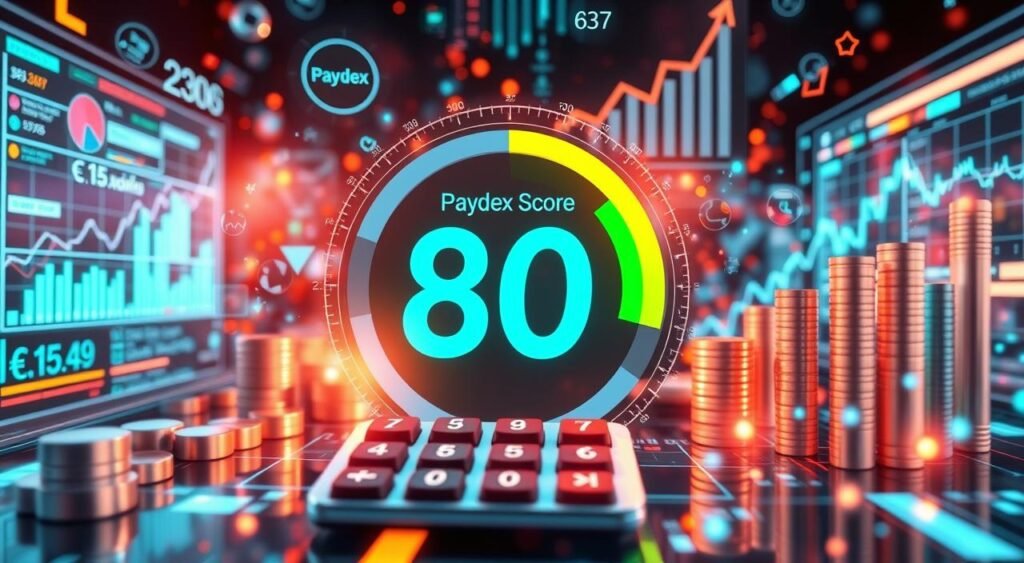Did you know that the number of trade experiences on US businesses has skyrocketed by 82% in recent years, from 63 million to 114 million1? As Paydex scores evolve, understanding these trends is key for businesses. In the next years, Paydex scores will see big changes, affecting risk assessment and credit management.
This article will look into the future of Paydex scores. We’ll cover how new technologies, laws, and alternative data will shape the credit world. By keeping up with these changes, your business can thrive in the evolving credit landscape.
Key Takeaways
- Paydex scores are vital for business-to-business decisions, showing the risk of late or non-payments.
- The Paydex score range is from 1-100, with 80 being a sign of timely payments and low risk2.
- Paydex scores are dollar-weighted, so paying off bigger debts has a bigger impact2.
- The number of US businesses with 1+ trade has increased by 69%, while those with 3+ trades (traditional Paydex) grew by 57%1.
- Small businesses (3.
Understanding the Paydex Score
What is the Paydex Score?
The Paydex score is a business credit score from Dun & Bradstreet (D&B). It looks at a company’s payment history over 12 months3. Scores range from 1 to 100, with 100 being perfect3.
Lenders and suppliers use it to check if a business can pay on time4. A score of 75 or higher is usually good5.
The score has different levels for payment timing3. Scores 1 to 49 mean payments are often late, 90 to 120 days or more. Scores 50 to 79 mean payments are up to 30 days late3. A score of 100 means payments are always on time3.
Having different types of credit can help a Paydex score3. Asking for higher credit limits can also improve it3. Checking the business credit report regularly helps find and fix errors that could hurt the score3.
“Maintaining a healthy Paydex score is crucial for businesses seeking trade credit, financing, and favorable terms from suppliers and lenders. It’s a key indicator of a company’s creditworthiness and payment performance.” –4
| Credit Score | Scoring Range | Risk Level |
|---|---|---|
| Dun & Bradstreet PAYDEX | 1-100 |
|
| Dun & Bradstreet Failure Score | 1,001-1,875 | Lower scores indicate higher risk of bankruptcy |
| Dun & Bradstreet Delinquency Score | 1-5 | Lower scores denote lower risk of payment deadlines missed by over three months |
| Equifax Payment Index | 0-100 | Higher scores signify lower risk of delinquent payments |
| Equifax Credit Risk Score | 101-992 | Higher scores indicate lower risk of delinquent payments |
| Experian Business Credit Score | 1-100 | Higher scores reflect lower risk of severely late payments |
| Experian Financial Stability Risk Rating | 1-5 | Lower scores indicate lower risk of bankruptcy or default within a year |
In summary, the Paydex score is key for checking a business’s credit and payment habits. Knowing about the score range helps businesses manage their credit and get better terms453.
Calculating the Paydex Score
The Paydex score is key for businesses. Dun & Bradstreet calculates it based on how quickly a company pays its suppliers and vendors6. It ranges from 0 to 100, with higher scores showing better creditworthiness7.
High scores, 80-100, mean low risk of late payments. Scores of 50-79 show medium risk, and 0-49 indicate high risk7.
The Paydex score weighs larger transactions more than smaller ones8. Dun & Bradstreet uses data from at least two trade references. Each reference must have at least three payment experiences.
The score shows how fast a business pays its bills. Faster payments mean a higher Paydex score7.
Early payments help boost the Paydex score more than on-time payments. Businesses with consistent, timely payments get higher scores8.
Having more vendors report to Dun & Bradstreet makes the Paydex score more reliable8.
Keeping business records clear and managing credit cards well can improve the Paydex score8. By knowing what affects the Paydex score, businesses can work on their payment processes. This helps keep a strong credit profile.

Paydex Score Trends
Watching your business’s Paydex score over time can give you insights into your payment habits and creditworthiness9. The score ranges from 0 to 100. Scores above 80 mean you’re low risk for lenders9. Dun & Bradstreet says you need at least three trade references from two different suppliers to get a score9.
The Paydex score weighs larger payments more in its calculation9. Scores from 80 to 100 show you’re low risk. Scores from 50 to 79 mean medium risk, and below 50, you’re high risk for late payments9. Keeping your score at 80 or higher shows you pay bills on time. This can help with better credit terms, loan approvals, and more9.
Keeping an eye on your Paydex score and payment trends helps you manage credit well. It’s key for making smart financing choices and building good vendor relationships.
| Credit Scoring Model | Score Range | Interpretation |
|---|---|---|
| PAYDEX Score | 0-100 | 10 Scores above 80 indicate low risk, 50-79 medium risk, and 0-49 high risk for late payments11. |
| Equifax Business Credit Risk Score | 101-992 | 10 Lower scores indicate higher risk of severe delinquency11. |
| Equifax Business Failure Score | 1000-1610 | 10 Lower scores indicate a higher risk of business failure through bankruptcy in the next 12 months11. |
| Experian Business Credit Score | 0-100 | 10 Scores 0-15 are high-risk, 16-30 medium-risk, 31-80 good credit, and 80-100 excellent credit11. |
It’s important to make sure your business credit report is correct and current10. How long info stays on your report varies. Trade data lasts 36 months, bankruptcies nine years and nine months, and judgments six years and nine months10.

“Monitoring your Paydex score trends can help you identify patterns in your payment behavior and make informed decisions about your business’s financial health and creditworthiness.”
The Impact of Emerging Technologies
Automation and AI in Credit Scoring
The future of Paydex scores will be shaped by new technologies. Automated Paydex Monitoring systems send alerts on credit changes. This lets companies fix payment issues fast. AI-Driven Credit Risk Assessment and Predictive Analytics for Business Credit help evaluate a company’s creditworthiness by spotting patterns12.
These technologies will make credit scoring more advanced and personal. They will give deeper insights into a company’s financial health and risk.
The D&B PAYDEX® score has improved lately due to government help during the pandemic. But, if this support ends too soon, it could get worse13. Also, the D&B® Failure Score for G7 countries has gotten worse, showing more businesses might fail13.
Businesses are now more worried about compliance and third-party risks. Dun & Bradstreet data shows a 50% increase in these concerns since 201913. There’s also a big jump in data enquiries for supply chain resilience, showing the need for Predictive Analytics for Business Credit13.
| Credit Scoring Solution | Offerings | Pricing |
|---|---|---|
| Dun & Bradstreet | Paydex score, Failure score, Delinquency score | Subscription plans available |
| Experian | Business credit score, Financial stability risk rating | $39.95 per report or $189 per year for subscription |
| Equifax | Payment index, Credit risk score, Business failure score | Free for businesses applying for loans or credit cards |
Keeping a good credit score can lead to better loans and lower interest rates. But, a low score might mean higher rates or loan denials14. By ensuring accurate and timely financial info, businesses can boost their Predictive Analytics for Business Credit and Paydex scores14.
As the business world changes, new technologies like Automated Paydex Monitoring and AI-Driven Credit Risk Assessment will be key. They help companies keep a good Paydex score and get better financing. By keeping up with these trends, businesses can succeed in the complex credit world.
Regulatory Changes and Compliance
The Paydex scoring system is key in business credit reporting. It faces changing rules and must follow strict guidelines15. Businesses need to keep up with these changes to avoid any issues with their Paydex score16.
It’s vital to keep the data for the Paydex score accurate and safe. Companies must follow data privacy laws and handle financial info carefully16. Staying compliant helps businesses keep a good credit score and avoid problems with money or suppliers.
The rules around credit scores like Paydex are changing a lot16. Lawmakers aim to make credit reporting fair and clear for everyone16. They enforce the Fair Credit Reporting Act (FCRA) to protect consumer credit reports16.
As rules in business credit reporting keep changing, companies must stay informed1516. Being proactive in following Paydex scoring and credit monitoring rules is crucial1516. This way, businesses can stay competitive and keep a solid credit standing.

“The Paydex score is a critical metric for businesses, and as regulatory changes continue to shape the credit reporting industry, staying compliant is essential for maintaining a robust credit profile.”
The Rise of Alternative Credit Data
Businesses need to keep up with the shift towards using alternative data for credit checks. Alternative Data Sources for Business Credit like online marketplaces and social media are now key. They help in figuring out Paydex scores17.
These Non-Traditional Payment Histories give a fuller picture of a company’s financial health and risk17.
The Dun & Bradstreet business credit score, or “The D&B® Delinquency Predictor Score,” comes from Dun & Bradstreet. It might not match other business credit scores17. This score is only for U.S.-based Bank of America small business clients with an active Small Business account17.
As Expanded Credit Evaluation Models come into play, businesses must adjust. They should make sure their payment history is up to date across all data sources. This helps keep a good Paydex score17.
By knowing what each model looks at, companies can improve their financial profile18.
The Paydex score goes from 1 to 100, showing how well a business pays on time. The FICO SBSS score, from 0 to 300, is key for getting loans from the U.S. Small Business Administration18. Businesses should figure out which score matters more in their field. Then, they can focus on improving that score to get better financing and terms18.
Global Business Landscape Shifts
The world is getting more connected, and Paydex scores will change with it. Companies going global face different payment rules and cultural differences. These can affect their credit scores19. They must watch their Paydex scores closely to show they’re creditworthy, as global supply chain issues or payment term changes can hurt their credit19.
Credit agencies need to update their scoring for global business changes20. Experian tracks over 27 million U.S. businesses and uses over 800 data points for its Intelliscore Plus score. This score ranges from 1 to 100, with higher scores meaning less risk20. Dun & Bradstreet’s PAYDEX score also ranges from 1 to 100, with scores above 80 seen as low risk. It focuses on payment history in its scoring20.
To keep a good credit score globally, companies should actively monitor and improve their Paydex scores19. Good credit scores can help get cash for growth, lower interest rates, and better payment terms. They can also lower insurance costs and increase company value19. Ways to improve business credit include paying bills on time, using different credit sources, and making small purchases with business credit cards. It’s also important to check credit scores and reports regularly for accuracy19.
As the global business scene keeps changing, the need for a strong Paydex score will grow. Understanding how international trade and cross-border credit monitoring affect business credit is key. This knowledge helps companies succeed in today’s interconnected world1920.
| Credit Scoring Model | Score Range | Key Factors Considered |
|---|---|---|
| Experian Intelliscore Plus | 1 – 100 | Payment history, current payment status, debt-to-credit ratio, and other factors to evaluate business health and payment behavior. |
| Dun & Bradstreet PAYDEX | 1 – 100 | Dollar-weighted indicator of a business’s payment performance, emphasizing payment history. |
| Equifax Credit Risk Score | 101 – 695 | Predicts the likelihood of business delinquency in the next 12 months. |
The Increasing Demand for Transparency
Businesses and consumers are now more aware of the need for clear credit reporting. This includes the Paydex scoring system8. They want to know what affects their Paydex scores and how to correct any mistakes8. As this need grows, companies like Dun & Bradstreet must offer better tools for managing credit profiles8.
Being open about credit scores helps businesses make smarter financial choices8. They can improve their payment habits and build stronger relationships with suppliers8. It’s important to keep an eye on Paydex scores and trade references, as on-time payments can boost these ratings8.
Also, more people are checking their commercial credit profiles21. They want to find and fix any errors that could hurt their credit22. By making Paydex scoring clear, credit agencies help everyone understand and manage their credit better8.
The need for clear credit reporting will keep growing as businesses change8. Agencies that offer easy-to-use tools and detailed info will keep their clients’ trust8.
Conclusion
The Paydex Score Outlook is changing, and businesses need to keep up. Knowing how to improve your Paydex score is key. This includes making timely payments23, using different creditors23, and avoiding negative marks23.
To get ready for the future of business credit, stay updated on new tech and rules. Also, watch how new data sources are changing credit reports.
To keep a strong credit score, focus on making payments on time23. Use credit monitoring tools and stay current with credit report changes. A good Paydex score23 can help you get better loans and work with vendors more easily.
By understanding trends and taking action, your business can grow and succeed. This is crucial for getting financing and expanding in the future.
The Paydex Score Outlook is moving towards more openness and using different data types2425. Stay informed and adjust your plans to keep a strong credit score. This will help your business achieve its goals.
FAQ
What is the Paydex Score?
How is the Paydex Score calculated?
Why is it important to monitor Paydex score trends?
How will emerging technologies impact Paydex scores?
How will regulatory changes affect Paydex scores?
What is the role of alternative credit data in Paydex scores?
How will globalization impact Paydex scores?
What is the trend towards greater transparency in Paydex scores?
Source Links
- The PAYDEX score is calculated by the Trade algorithm which examines individual experiences, classifies them into various classes, weights them according to the dollar amounts for each category and then multiplies by the individual index weight to comput – https://docs.dnb.com/static/doc-uploads/supplier/en-US/support/FAQs.pdf
- Understanding the Paydex Score – https://www.businessinsider.com/personal-finance/credit-score/what-is-paydex-score
- PAYDEX® Business Credit Score Guide – Huddle Business Capital – https://huddlebc.com/blog/paydex-score-guide
- Understanding Business Credit Scores – Credit Strong – https://www.creditstrong.com/business/business-credit-scores/
- Understanding Business Credit Scores | Capital One – https://www.capitalone.com/learn-grow/business-resources/business-credit-scores/
- Paydex | HighRadius™ | Autonomous Finance | A/R Management Software – https://www.highradius.com/glossary/paydex-meaning-and-definition/
- How to Check Your Business Credit Score: PAYDEX Score & More – https://www.creditsuite.com/blog/how-to-check-your-business-credit/?srsltid=AfmBOor2GjVM_zBvQAz-BB10zcce4L89tSJyJEj06klOmELLDBTOdMQz
- The Essential Guide to Understanding What is a Paydex Score and Net 30 Vendors – https://theceocreative.com/the-essential-guide-to-paydex-scores-and-net-30-vendors/
- What Is A Paydex Score? | Bankrate – https://www.bankrate.com/credit-cards/business/what-is-paydex-score/
- Understanding the Three Major Business Credit Bureaus – https://www.score.org/resource/article/understanding-three-major-business-credit-bureaus
- How to Check Your Business Credit Score: PAYDEX Score & More – https://www.creditsuite.com/blog/how-to-check-your-business-credit/?srsltid=AfmBOor6TmPP35ZdTa_81bn6vWNOGHG0vT05Q54xnTEN5QsVn1v9aFBT
- Business credit rating forecast: The Impact of Economic Trends on Business Credit Scores – FasterCapital – https://fastercapital.com/content/Business-credit-rating-forecast–The-Impact-of-Economic-Trends-on-Business-Credit-Scores.html
- Compliance, Climate Economics And Global Inflation: Data And Business Trends For 2022 – https://www.ceotodaymagazine.com/2022/02/compliance-climate-economics-and-global-inflation-data-and-business-trends-for-2022/
- Credit Score Impact on Small Business Financing Options | Republic Bank of Chicago – https://republicebank.com/credit-score-impact-on-small-business-financing-options/
- Top business credit scoring companies & how they work – https://www.highradius.com/resources/Blog/top-credit-scoring-companies/
- Credit Score Regulation: The Impact of Credit Score Regulation on Small Business Loans – FasterCapital – https://fastercapital.com/content/Credit-Score-Regulation–The-Impact-of-Credit-Score-Regulation-on-Small-Business-Loans.html
- Credit score basics for Small Businesses – https://business.bankofamerica.com/resources/credit-score-basics-for-small-businesses.html
- Paydex vs FICO What Wins for Businesses – https://nichecapitalco.com/paydex-vs-fico-what-wins-for-businesses/
- The Importance of Business Credit Scores – https://www.chase.com/business/knowledge-center/start/business-credit-scores
- Business credit rating intelligence: Comparing Business Credit Bureaus: Experian vs: Dun: Bradstreet – FasterCapital – https://fastercapital.com/content/Business-credit-rating-intelligence–Comparing-Business-Credit-Bureaus–Experian-vs–Dun—Bradstreet.html
- How To Improve Your Business Credit Score – Tillful – https://www.tillful.com/resources/how-to-improve-your-business-credit-score/
- D&B Report – Dun and Bradstreet Business Credit Report – https://northshoreadvisory.com/business-credit/business-credit-reports/dun-and-bradstreet-business-credit-report/
- What is a Paydex Score — Key to Business Creditworthiness! – https://www.linkedin.com/pulse/what-paydex-score-key-business-creditworthiness-paycron-inc-cptee
- Business credit score model: Comparing FICO SBSS and Dun: Bradstreet PAYDEX Scores – FasterCapital – https://fastercapital.com/content/Business-credit-score-model–Comparing-FICO-SBSS-and-Dun—Bradstreet-PAYDEX-Scores.html
- ec 201310 why small business lending isnt what it used to be – https://www.clevelandfed.org/publications/economic-commentary/2013/ec-201310-why-small-business-lending-isnt-what-it-used-to-be

